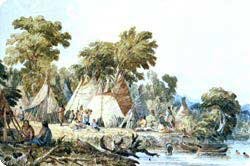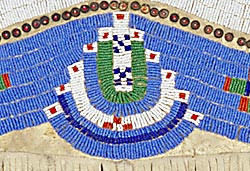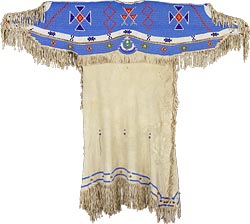
20th century
Leather, cotton, copper, and glass beads
Gift of James David and John David
|
The Lakota were once part of a much larger group of people, the Dakota, who lived in the northern woodlands, including the southern
two-thirds of Minnesota. Within the Dakota were three closely related language groups-the Dakota-speakers, the Nakota-speakers,
and the Lakota-speakers. They did not travel from place to place, but settled in one area living in bark lodges in the forests,
harvesting wild rice, and making maple sugar. Invasions by the French in the 1640s and ensuing battles with their own Indian enemies
forced many Nakota and Lakota to move westward. They developed distinctive Plains cultures. The Lakota acquired horses, introduced
to North America by the Spanish in the 17th century, and by the 18th century were nomadic buffalo hunters. |

|
Seth Eastman
Dacotah Encampment
Watercolor
Courtesy W. Duncan and Nivin MacMillan and the Afton Historical Society Press |

|
Detail of beadwork from the Woman's Dress |
By the mid-19th century, Euro-American settlers had overrun the sacred lands of the Lakota, and white hunters had decimated the buffalo
herds on which the Plains Indians, the varied people who lived between the Mississippi River and the Rocky Mountains, depended.
Eventually the United States government confined the Plains Indians to designated lands called reservations. Although reservations
deprived them of their traditional way of life, the Lakota struggled to preserve many of their cultural traditions.
Quilling and Beading
QUILLWORK
was the primary art form of traditional Lakota women. They decorated clothing and other surfaces with
GEOMETRIC
designs elaborately embroidered with dyed porcupine or bird quills. When colorful glass beads became readily available from
Euro-American traders, they began to replace quills in embroidered ornamentation. Beads were easier to acquire, easier to use, and
came in a wide variety of bright colors. Beadworkers strung several beads onto a thread and then stitched them down at intervals
to create colorful and often
SYMBOLIC
patterns. The enforced restriction on travel and economic hardships of reservation life spurred a golden age in Lakota beadwork,
especially as beaded objects became valued items in the tourist market.
Turtle
Lakota dance dresses are traditionally decorated with a beaded yoke that incorporates the turtle-by-the-shore-of-the-lake design.
Because of her role in the creation story of the Lakota, the turtle is a sacred animal. The Lakota associate women with the sacred
turtle because of their gift of creating human life. Lakota women aspired to be like the turtle - resilient and long-lived. Turtle
MOTIFS
(moe-TEEFS) were beaded on women's dresses, leggings, and bags and on cradle boards and protective umbilical amulets for baby girls.1
Woman's Dress
This was the "best dress" of a Lakota woman, worn for dancing or for special occasions.2 When a woman danced in this
dress, the beaded yoke sparkled in the sunlight, the fringe swung up and down, and the bells jingled.
 |
Rollover the image to locate details from the Woman's Dress |
The beaded designs on the yoke have spiritual power and significance. At the lower center of the yoke, resting directly over the wearer's
heart, is a multicolored U-shaped design representing the sacred turtle. The narrow white strip across the width of the yoke is the
lakeshore. The blue-and-gold design in the white strip above the turtle may represent a morning star, and the checkered designs around
it may suggest mountains or hills. Above the white strip, the broad blue area punctuated by
SYMMETRICAL
designs represents the sky's reflection in the waters of the lake, the home of the sacred turtle.3 While the meaning of most of these
designs is no longer known, designs in this part of a Lakota dress traditionally referred to spiritual beings who lived in the sky and
on the lakeshore. By the early 20th century, when this dress was made, Lakota artists often used such designs for aesthetic or visual
effect alone.
1 These amulets were used to hold the baby's umbilical cord and provide good luck in many tribes.
Boys received amulets in the shape of lizards (the symbol of long life and wisdom) while girls' amulets were shaped like turtles.
Some tribes tied the amulet onto the baby's cradleboard, where it served as the child's first toy. In other cultures, the child's
mother wore the amulet.
2 A woman tanned, cut and sewed the hides used to make this dress.
3 Father Peter J. Powell, D. D., "Beauty for New Life: An Introduction to Cheyenne and
Lakota Sacred Art," in Evan M. Maurer, The Native American Heritage: A Survey of North American Indian Art (Chicago: The Art
Institute of Chicago, 1977), p.45.
|











